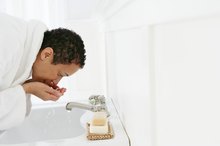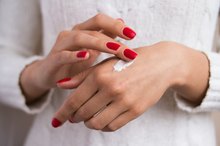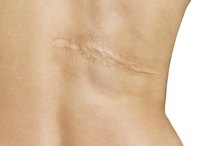If you suffer from rosacea, the redness it causes can make you feel like everyone is staring at your skin condition. The rash-like facial appearance accompanied by enlarged pores can cause social anxiety as well as lower self-esteem. Knowing how to minimize the appearance of rosacea and large pores, while also reducing flare-ups, can improve your self-image.
Rosacea
Rosacea is a chronic skin disorder that causes redness of the face. According to the National Rosacea Society (NRS), rosacea often appears on patients after the age of 30, and fair-skinned individuals often have the highest risks 1. The symptoms of rosacea often include persistent redness, blushing or flushing easily, acne-like bumps and visible blood vessels. Some additional symptoms are eye irritation, a rough appearance, red patches, thickened skin and swelling.
According to the NRS, women are diagnosed more often than men; however, men have the most severe symptoms.
- Rosacea is a chronic skin disorder that causes redness of the face.
- The symptoms of rosacea often include persistent redness, blushing or flushing easily, acne-like bumps and visible blood vessels.
Pores
Sun Damage or Rosacea?
Learn More
Pores are small openings in the skin that protect the skin from the environment by bringing necessary oils to the surface. Pores can become blocked, which causes acne. If you suffer from acne breakouts, there's a good chance you have enlarged pores. As the pore becomes clogged with an acne-causing oil called sebum, the clogged pore will stretch. Before your mid-twenties, your skin is able to bounce back to its original state once the pore is unclogged, but starting in your late twenties your skin begins to age and lose elasticity, causing the pore to remain enlarged. When acne accompanies rosacea, it's called acne rosacea.
According to the International Rosacea Foundation, facial pores become larger and more prominent when acne-like bumps are present with rosacea. In addition, skin thickening and swelling caused by the form of rosacea known as rhinophyma also makes the pores enlarged.
- Pores are small openings in the skin that protect the skin from the environment by bringing necessary oils to the surface.
- As the pore becomes clogged with an acne-causing oil called sebum, the clogged pore will stretch.
Triggers
NRS surveyed 1,066 rosacea patients and found the top three triggers are sun exposure, emotional stress and hot weather. Many rosacea patients have a variety of triggers, and not all experience the same results from the same trigger. There are hundreds of sources that can cause a rosacea flare-up, so finding out what causes the redness can help you eliminate it from your daily activities. Some other factors are alcohol, spicy foods, exercise and wind.
- NRS surveyed 1,066 rosacea patients and found the top three triggers are sun exposure, emotional stress and hot weather.
Regimen
Does Cetaphil Lotion Help Rosacea?
Learn More
Use a mild cleanser and moisturizer. Do not use an exfoliating product since this can cause irritation for rosacea sufferers. Look for products for sensitive skin that are fragrance free.
Always apply a sunblock with an SPF of 30 to minimize the effects that sun has on rosacea. If possible, look for a moisturizer that already includes sunblock in order to minimize the number of products on your face.
Cosmetics can trigger rosacea flare-ups and make skin appear blotchy in areas with enlarged pores, so avoid full-face cover-ups.
- Use a mild cleanser and moisturizer.
- Always apply a sunblock with an SPF of 30 to minimize the effects that sun has on rosacea.
Treatment
The symptoms and triggers for rosacea can vary from patient to patient, so a dermatologist will not necessarily prescribe or suggest the same treatments for everyone. A dermatologist may start by giving you samples of products to try in order to determine the most successful route. Topical creams are most often prescribed for rosacea patients; however, oral medications can be administered as well.
It is impossible to make pores smaller; however, there are ways of reducing the appearance of pores. Unfortunately, most methods available to reduce the appearance of large pores are too abrasive for a patient with rosacea. Treatments for pores may include chemical peels and dermabrasion.
- The symptoms and triggers for rosacea can vary from patient to patient, so a dermatologist will not necessarily prescribe or suggest the same treatments for everyone.
- Unfortunately, most methods available to reduce the appearance of large pores are too abrasive for a patient with rosacea.
Related Articles
References
- National Rosacea Society: All About Rosacea
- Al-balbeesi AO, Almukhadeb EA, Halawani MR, Bin saif GA, Al mansouri SM. Manifestations of ocular rosacea in females with dark skin types. Saudi J Ophthalmol. 2019;33(2):135-141.doi:10.1016/j.sjopt.2019.01.006
- Gallo RL, Granstein RD, Kang S, et al. Standard classification and pathophysiology of rosacea: The 2017 update by the National Rosacea Society Expert Committee. J Am Acad Dermatol. 2018;78(1):148-155.doi:10.1016/j.jaad.2017.08.037
- Han J, Liu T, Zhang M, Wang A. The relationship between inflammatory bowel disease and rosacea over the lifespan: A meta-analysis. Clin Res Hepatol Gastroenterol. 2019;43(4):497-502.doi:10.1016/j.clinre.2018.09.009
Writer Bio
Melissa McNamara is a certified personal trainer who holds a Bachelor of Arts in journalism and communication studies from the University of Iowa. She writes for various health and fitness publications while working toward a Bachelor of Science in nursing.









